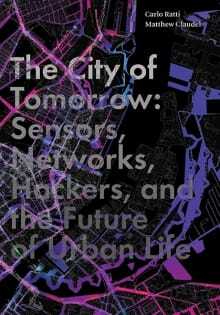The City of Tomorrow: Sensors, Networks, Hackers, and the Future of Urban Life
Carlo Ratti and Matthew Claudel
Yale University Press
P.O. Box 209040, New Haven, CT
06520-9040; yalebooks.com.
2016. 184 pages. Hardcover, $20.00.
In The City of Tomorrow: Sensors, Networks, Hackers, and the Future of Urban Life, the authors use “futurecraft”—not predicting the future, but influencing it positively—to present ideas about what the city will look like years from now. Authors Carlo Ratti and Matthew Claudel work at the Massachusetts Institute of Technology Senseable City Laboratory studying the intersection of technology and the built environment, and that is the focus of the book.
Ratti and Claudel point out that many past predictions have been proven wrong. Many observers thought that the internet would erase the need for people to meet—but they did not take human nature into account. Cities kept growing, and now they are at the intersection of physical and virtual. The resulting smart city is a hybrid in several areas that the book explores, from architecture to transportation to energy.
In architecture, they focus on cybernetics, which in this context means that buildings function as “adaptive learning entities living in a kind of dialogue with their inhabitants.” An example is the Digital Water Pavilion designed by Carlo Ratti Associati for the 2008 World Expo in Zaragoza, Spain. Told to use water as an architectural element, the designers created a flexible space with walls made of drops of water that react to the presence of humans by parting at their approach to create an entrance or exit.
More broadly, the book suggests, the result of omnipresent computing will not be optimized production—an age-old dream of urban planners—but an empowered citizenry. Smartphones are the embodiment of that trend. Their ubiquity, say Ratti and Claudel, means “every citizen has a tool with which to perceive and process the city.”
Continuing in that vein, the authors investigate how the spread of smart technology to every area of people’s lives will affect city life. With the widespread use of 3-D computers and other digital tools, labor and production could become more decentralized. Society would become more local and user-centric, returning to a preindustrial model. Habitation and work patterns might recall medieval cottages in Great Britain, where work and home shared space. Alternatively, workspaces could be spread throughout the city, with an open infrastructure so that workers could share knowledge, create, and socialize.
With their broad computing power, future urban citizens will be able to “hack the city.” In its most positive sense, hacking means exploring the limits of what’s possible, with a blurry line between “good” and “bad” hackers. It can include hacking a physical space, such as the 1993 project for World AIDS Day in which the artist Olivero Toscani installed a giant pink condom on the Luxor Obelisk at the Place de la Concorde in Paris. An example that shows the intersection of social media and physical space is the protests in Tahrir Square in Cairo during the Arab Spring of 2011.
Ratti and Claudel touch on many aspects of city life in a short space, exploring how virtual and physical space will relate in future urban life. They say at the start that they intend to present ideas for debate, not to make predictions—a caveat that is well advised in this field of unknowns.


![Western Plaza Improvements [1].jpg](https://cdn-ul.uli.org/dims4/default/15205ec/2147483647/strip/true/crop/1919x1078+0+0/resize/500x281!/quality/90/?url=https%3A%2F%2Fk2-prod-uli.s3.us-east-1.amazonaws.com%2Fbrightspot%2Fb4%2Ffa%2F5da7da1e442091ea01b5d8724354%2Fwestern-plaza-improvements-1.jpg)


